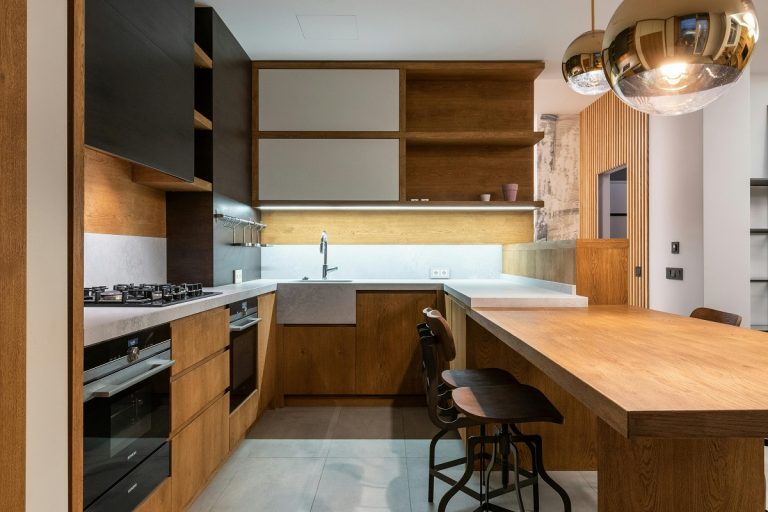

The home improvement industry has seen a significant uptick, with more homeowners choosing to enhance their living spaces. Data shows that nearly 60% of homeowners embarked on at least one home improvement project in the past year. This trend underscores the growing interest in creating functional, aesthetically pleasing environments.
Understanding the importance of home maintenance is crucial. Regular home improvement preserves your property’s integrity and can significantly increase its market value. As 2024 approaches, it’s wise to consider projects that add to your home’s comfort and contribute to its long-term worth. Here’s your guide to help identify key home improvement projects that will benefit the upcoming year.
1. Replace Your Roof

The roof is a critical home component, the first defense against the elements. Statistics reveal that a well-maintained roof can add significant value to a property, with experts suggesting that roof replacement offers a return on investment of up to 70%. This underlines the importance of roof maintenance as a critical aspect of home improvement. When considering roof replacement, it’s essential to weigh various options. Here are some ways to replace your roof, each with its own set of considerations:
Choosing the Right Material: The roofing material significantly impacts your roof’s durability, cost, and appearance. Common materials include asphalt shingles, metal, and tiles. Asphalt shingles are cost-effective and versatile, while metal roofing is durable and energy-efficient. Tiles, on the other hand, offer a unique aesthetic appeal but are more costly. Consulting with roofing contractors can help determine the best material for your needs and climate.
Hiring Professional Roofing Services: Engaging professional roofing services ensures that the job is done efficiently and safely. Experienced roofing contractors can provide valuable insights into your situation’s best materials and methods. They also offer warranties and guarantees on their work, providing peace of mind that your investment is protected. Choosing a reputable and licensed roofing company is crucial for a successful replacement.
Considering Energy Efficiency: Modern roofing technologies offer energy-efficient options like reflective coatings or insulated roofing systems. These features can help reduce heating and cooling costs, making your home more comfortable and environmentally friendly. Many roofing companies now specialize in these energy-efficient solutions, offering a range of options to suit different budgets and preferences.
Regular Maintenance and Inspection: After roof replacement, regular maintenance is critical. This includes routine inspections, especially after severe weather conditions. Maintenance can identify and address minor issues before they escalate, extending the lifespan of your new roof. Roofing contractors typically offer maintenance and inspection services, ensuring your roof remains in top condition.
Budgeting for Roof Replacement: Roof replacement can be a significant investment. Setting a realistic budget and discussing it with your chosen roofing company is essential. They can provide options that balance quality and cost, ensuring you get the best value for your money. Financing options and payment plans are often available, making it easier to manage the financial aspect of roof replacement.
2. Upgrade Your Floors

Flooring is often one of the first aspects people notice upon entering a house. It significantly impacts your home’s aesthetic appeal, comfort, and value. High-quality flooring can also enhance the functionality of a space, making it more durable and easier to maintain. Essentially, upgrading your floors is not just about beauty; it’s about creating a foundation that complements and elevates your living space. Below are key steps and factors to consider:
Selecting the Right Material: The choice of flooring material is crucial and should align with your aesthetic preferences and practical needs. Popular options include hardwood, which offers timeless elegance and durability; laminate, known for its versatility and cost-effectiveness; and luxury vinyl, which balances durability and style. Each material has unique benefits and limitations, so it’s vital to assess your lifestyle and the specific needs of each room before deciding.
Hiring a Professional: Professional installation is critical to ensuring your new floors are beautiful, properly installed, and durable. A skilled flooring contractor can offer expert advice on the best materials and installation techniques for your situation. They ensure precision in installation, which is crucial for the longevity and appearance of your flooring.
Considering Eco-Friendly Options: Sustainability is an increasingly important aspect of home improvement. Numerous eco-friendly flooring options are available, such as bamboo, cork, and recycled materials. These choices not only contribute to a healthier environment but can also offer unique aesthetic appeal and durability.
Budgeting for Your Flooring Project: Flooring upgrades can vary significantly in cost depending on the materials and scope of the project. Setting a realistic budget and discussing it with your flooring contractor is essential. They can help you navigate various options to find a balance between quality, style, and cost. Many contractors also offer financing options or payment plans to help manage the investment.
Maintenance and Longevity: Consider the maintenance requirements and longevity of different flooring materials. Some materials may require more frequent care but last longer, while others might be low maintenance but less durable. Understanding these trade-offs helps you make an informed decision that suits your lifestyle and long-term home improvement goals.
3. Invest in a Pool

Investing in a pool is a substantial home improvement project that can dramatically enhance your property’s aesthetic appeal and recreational value. A pool not only serves as a center for relaxation and entertainment but can also increase the overall value of your home. With the right design and features, a pool can transform your backyard into a personal oasis, offering a unique blend of luxury and functionality. To successfully integrate a pool into your home improvement plan, the following are several key steps to consider:
Determining the Purpose and Design: Before embarking on pool installation, consider what you want from your pool. Is it for family fun, fitness, entertainment, or a combination? The purpose will significantly influence the design, size, and features of the pool. Options range from simple above-ground pools to elaborate in-ground designs with unique shapes, water features, and integrated landscaping.
Choosing the Right Swimming Pool Company: Partnering with a reputable swimming pool company is critical for a successful project. Look for companies with a strong track record and positive customer reviews. A good company will assist in design and installation and guide you through the necessary permits and regulations. They should offer comprehensive services, from initial design to final construction.
Understanding Different Types of Pools and Materials: There are various types of pools, such as in-ground, above-ground, fiberglass, concrete, and vinyl-lined. Each has its advantages and limitations regarding cost, durability, and maintenance. Swimming pool liners, for instance, are crucial for protecting the pool’s structure and maintaining water quality. Your choice should align with your budget, maintenance capacity, and aesthetic preferences.
Budgeting for Your Pool Project: Pool installation can be a significant investment. It’s important to establish a budget that includes the initial construction costs and ongoing maintenance and utility expenses. Discuss your budget with the swimming pool company to explore various options and find the best solution within your financial constraints.
Landscaping and Surrounding Area: Integrating the pool with your landscape design enhances its appeal and functionality. Consider the placement of the pool about your home, garden, and outdoor living areas. Landscaping, decking, and furnishings play a big role in creating a cohesive and enjoyable outdoor space.
Maintenance and Upkeep: Regular maintenance is essential to keep your pool in top condition. This includes cleaning, balancing water chemistry, and inspecting swimming pool liners and equipment. Some swimming pool companies offer maintenance services, or you can do it yourself with the right tools and knowledge.
Safety Considerations: Safety is paramount when it comes to pool installation. Ensure your pool complies with local safety regulations, including fencing, alarms, and covers. A responsible swimming pool company will advise on the best safety features for your specific pool design.
4. Build a Concrete Patio

A concrete patio is a valuable addition to any home, serving as a versatile and durable outdoor space for relaxation, entertainment, and enjoyment of the natural surroundings. In the realm of home improvement, a well-designed patio not only enhances the aesthetic appeal of your outdoor area but also increases the functionality and overall value of your property. Concrete, with its durability and low maintenance, is an excellent material choice for creating a long-lasting and visually appealing patio. Here’s how to execute a concrete patio project, along with ideas for upgrades:
Design and Planning: The first step is to design your patio. Consider the size, shape, and location that best fits your outdoor space and meets your needs. Consider how you plan to use the patio – whether for dining, lounging or as a play area – and design accordingly. Also, plan for any additional features such as fire pits, seating, or landscaping that you might want to include.
Choosing Local Concrete Contractors: For a successful patio project, it’s crucial to work with experienced local concrete contractors. They can provide expert advice on the design, preparation, and installation. Look for contractors with a solid reputation and portfolio of previous work. They should be able to handle the project from start to finish, including obtaining any necessary permits.
Selecting the Right Concrete Supply: The quality of the concrete used is vital for the durability and appearance of your patio. Discuss with your contractor the best type of concrete for your project, considering factors like climate, the expected load, and aesthetic preferences. Various finishes and colors are available in concrete supply to match your home’s style.
Preparation and Installation: Proper ground preparation is essential for a long-lasting patio. This involves grading the area, ensuring proper drainage, and preparing a suitable base for the concrete. The concrete is poured, leveled, and finished according to your chosen design and texture.
Upgrading Your Patio: Consider these upgrades for your concrete patio:
- Stamped Concrete: Opt for stamped concrete to introduce rich textures and intricate patterns to your patio, mimicking the natural beauty of stone, brick, or wood. This technique not only elevates the visual appeal of your patio but also adds a touch of sophistication and uniqueness to your outdoor space. Stamped concrete is an excellent choice for homeowners seeking a high-end look without the cost and maintenance associated with actual stone or wood.
- Colored Concrete: By integrating color into your concrete mix or applying surface stains, you can transform your patio into a vibrant and personalized space. This customization allows you to match your patio with the existing color scheme of your home or garden or to create a bold statement piece. Using color in concrete provides an opportunity to infuse personality and artistic flair into your outdoor area.
- Functional Upgrades: Enhance the utility and entertainment potential of your patio by adding an outdoor kitchen or bar, perfect for hosting gatherings and enjoying meals outdoors. Incorporate durable built-in concrete seating to provide comfortable and permanent seating options for your guests. Additionally, integrated lighting not only adds a warm ambiance but also extends the usability of your patio into the evening hours, making it a perfect spot for relaxation or socializing under the stars.
Maintenance and Care: Although concrete patios are renowned for their durability, they still need regular upkeep to maintain their aesthetic appeal. Regular cleaning, involving sweeping and occasional washing, can prevent dirt and stains from accumulating. Additionally, resealing the concrete every few years can protect it from weather elements and wear and tear and enhance its color and finish, ensuring it remains an attractive feature of your home.
Landscaping Integration: Integrating your new patio with the existing landscaping is key to creating a harmonious and inviting outdoor space. Consider the styles and colors of your home and garden, and choose plants, shrubs, and trees that complement the patio’s design and the overall ambiance you wish to create. Additionally, adding elements like pathways, lighting, or water features can further enhance the connection between the patio and the surrounding landscape, making it a seamless extension of your living area.
Conclusion
As 2024 approaches, homeowners should consider key home improvement projects such as roof replacement, flooring upgrades, pool installation, and building a concrete patio, each offering unique benefits in terms of functionality, aesthetics, and property value. These projects not only enhance the livability and appeal of your home but also represent smart investments in the long-term value of your property.


